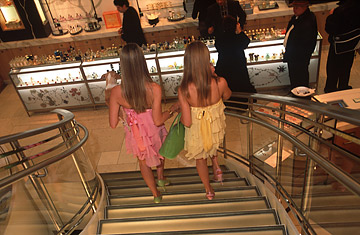
While young women still shop with their friends, more and more are hitting the stores with their mother.
(2 of 2)
One of the first retailers to target a psychographic instead of a demographic was the wildly popular Scoop NYC specialty store. "We don't think about age," says fashion director Danielle de Marne, 26, who fills Scoop NYC stores with everything from Splendid T shirts to Azzedine Alaa dresses. "We buy for a woman with body confidence. Nothing is off-limits anymore."
De Marne's own mother benefits from her daughter's expertise. "She had a tendency not to go for flattering silhouettes, so I buy for her here," says De Marne. "She trusts my taste." Her last successful score was to get her mother—a 56-year-old teacher—to try belting a long KA7 cardigan over Citizens of Humanity jeans. But De Marne says she has also seen millennials pushing their mothers to buy things they want for themselves, something NPD's Cohen says he sees frequently. "The mother buys it," he says. "And six months later, it's in the daughter's closet."
Designer Tory Burch says she intentionally designs clothing that can be worn in different ways and so attracts both demographics to her stores. While the daughter might wear one of Burch's signature tunics belted as a minidress, the mother can wear it over skinny jeans. "It's all in how you style it," says Burch, 41, whose stepdaughters, both in their early 20s, recently persuaded her to wear skinny jeans.
The millennials' appetite for luxury is good news for retailers because, as Harrison points out, "it wears off on the parents around them." One look at a college parking lot full of Audis, Saabs and BMWs demonstrates that this generation isn't waiting to "earn" its luxury products and services; it already feels entitled to them. "There's an expectation that they deserve luxury now—it's not something you wait for and earn," says James Chung, president of Reach Advisors, who is working on a survey of purchasing behavior of young women. "I call them the prematurely affluent generation."
So who's paying the bills? Generally, when you have the parent in the store, you have the wallet in the store, according to Cohen. So stores have to influence not only the consumer but also the credit-card holder. Which can be tricky. Take designer sunglasses, for instance. "The mother wants the discreet logo at the temple," says Cohen, "and her daughter wants the logo to be bigger than the lens." So a slightly different product might be needed for each shopper, and different marketing—different ads. "Welcome to the new world," says Cohen. "You can't just sell to one market segment."